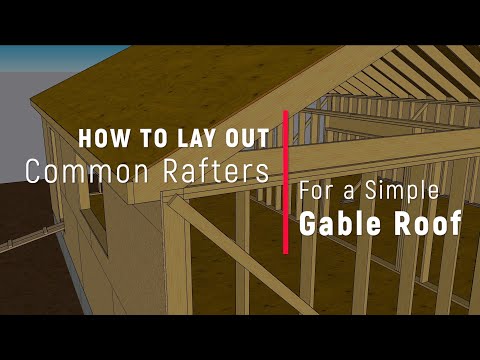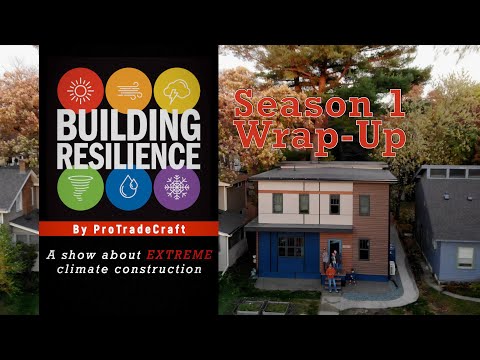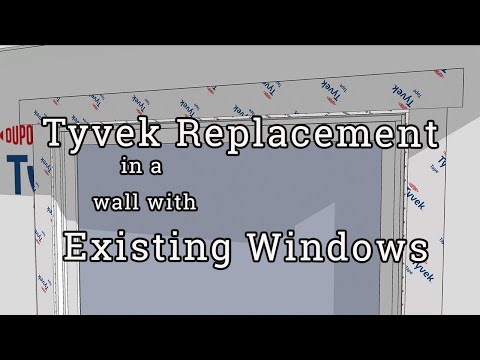An instant airtight and watertight roof deck
In the last episode of Building Resilience, we were exploring a complex system of floor beams, framing a floor on top of that, and walls on top of that.
We discovered that while this little addition has only three walls, each one has a very different job and so each one has a very different profile. The most interesting wall was Wall Type 2: The shear wall.
MA: This is our wall type two. It’s a shear wall. We have OSB on the outside of this wall, and on the inside of this wall. And then we have our ZIP System R-12 Insulated sheathing outside that.
So essentially we end up with three layers of 7/16-inch OSB on this wall.
Its heavy, it’s not going to move, and that’s important because hanging from this opening is going to be a giant glass box.
They’re sheathing with ZiP’s exterior insulated sheathing product called ZIP R-12, but they’re not wrapping the house with it yet.
First, they need to get an airtight and watertight lid on the house so the family below doesn’t get cold and wet.
And as usual in Minneapolis, cold and snow is in the forecast.
MA: Awww, That’s pretty cool
What’s not cool is that they found a layer of soggy sponge under the roof covering.
Turns out, there were some hidden leaks that were isolated, but not victimless.
Michael Anschel: The rubber roof that was up here has some holes in it, the buffalo board was soaked, but the tar paper that was mopped under here kept all this really pretty dry and brittle and old, which is ultimately a great thing.
So, we also have this huge opportunity now because we have this two-foot cavity which is between the old roof deck and the plaster ceiling below.
There’s currently about two-inches of cellulose in here—not enough for Minnesota. But we have this giant void, so what we’re going to do is come back and net all of this on both sides and blow the cavity full of blown-in fiberglass. We’ll end up with 24 inches of insulation, so that’s pretty darned close to R-80, I’ll do the math later.
It’s more than enough and the house should be pretty comfortable.
So we’re going to insulate between the ceiling and the subdeck here, but this is not the finished surface. Over the top of this is framing and another layer of ZIP System roof decking and that’s all going to get taped.
So our air barrier is up here, and we’ll actually have a small pocket of dead air space, but impossible to vent. We’re not going to vent it. And then we’ll have about R-80 sitting below that.
So this old balloon framed house, we knew basically how they built it but weren’t 100% sure until we opened it up.
And we had a bunch of theories about how they built this roof structure and none of them were right.
So, here we’ve got the top plate, but the roof starts below it, right here, and slowly moves up above the top plate until it’s a full six inches above the top plate on the opposite end.
The entire roof structure is hanging off of a ledger attached to the wall. That’s pretty typical for balloon-framing, but somebody put a lot of time, thought, and energy into making this work.
And for 102 years, it has worked really well.
With the old rubber and asphalt roofing stripped off the 102 year old deck, the roof framing plan is set in motion.
Steve will frame a simple low-slope hipped roof atop the existing one. The hip style with such a low slope will give the appearance of a flat roof when seen from the street.
Over the framing is ZIP System roof sheathing taped at the seams to complete the primary air barrier as well as sealing against water.
Basically, after this roof is sheathed, it will also be dried in.
All of that begins, though, with exploring what is inside that can of worms, before it is opened.
Step one is to convince the cameraman to set the camera down and pick up a grade stick.
After benchmarking all of the corners, Steve peeks at the middle. Just for schucks and giggles.
Looks like there is quite a belly to this roof
Steve: quite a belly.
Step one of framing the roof is setting the ridge beam, so he levels the ridge beam across, temporarily tacking it in place to test drive various rafter scenarios.
Steve: I'm trying to get a rough idea...
Inevitably that includes sentences that trail off...
to see what my pitch is. Cause basically…
...and a carpenter muttering numbers
...naw, that’s not gonna work.
like 17-½…
What he is nervous about is that the addition also has a flat roof and the ridge of this little hip roof should not extend above the addition’s flat roof.
That would be a simple problem to solve, if the trusses were on site, but alas, the trusses for that roof had not arrived yet.
With a rough idea of what’s about to unfold, he frames the ridge and braces it level.
Now that he has committed to a number—trusting that the trusses will be what they are supposed to be—the trusses have arrived.
So they stack the trusses on the old roof for the time-being.
With the trusses on the roof and the crane slipping them into place, the crew drops ‘em in, braces them plumb, and spaces them evenly.
Now comes the tricky part: the end truss.
The guys added sheathing to the outside of the truss and also screwed on the giant barge rafter which creates an 18-inch overhang.
It is heavy, unwieldy, and unfortunately, out of the reach of the crane. So they have to set it in place the old-fashioned way—one inch and near-heart attack at a time.
They set it atop the trusses and slide it out. Now, all that’s left to do is tilt it into position and slip it into the pocket.
But that's a lot easier said than done.
Now they brace the top quickly and they toenail the bottom to the line snapped on the top plate
Next comes the ZIP System roof sheathing.
On such a flat roof, running roof sheathing is a lot like running subflooring.
Begin with a line snapped across all of the rafters to keep the sheets parallel to the edge of the roof.
Put the corner of the ZIP panel on the line and nail it.
Pull layout from that first nailed rafter marking the sheets so that the rafters maintain the correct spacing as you work your way across the roof.
The end of the panel should split the rafter.
You pretty much keep doing this over and over until you either run out of sheets or run out of roof. Hopefully, it's the latter.
The outer edges of the roof are nailed last, so that the truss can be plumbed with the wall.
MA: This is the first time that we’ve used Zip System roof decking. And we’re pretty excited. We saw that video showing how well it stands up under hurricane-force wind and rain just being taped. And that adds a degree of confidence for us when we’re framing out a flat roof like this. We love EPDM, we love flat roofs and TPO, they work really well. But being able to be dried in while we work, before the roof goes on is going to help us with our timeline and if there’s a failure in the EPDM at some point, the likelihood that we’ll see that come in, is lower. I feel like that’s an extra layer of protection that we’ve got in there now.
The primary air barrier and water barrier is set at the roof level with Zip tape.
Steve: Today we’re going to finish framing and sheathing the front eyebrow on the house, get this assembly totally buttoned up and dried in. And then move down to the wall sheathing.
What do you think of this Zip System?
It’s fantastic. It’s fast, it’s totally dried in. Its bomber.
I’m really happy about this connection (roof to wall) and I think that having this building tied together, waterproof, and quite honestly airtight is a huge advantage at this point in construction.
MA: I was just thinking about that. We just added all of that insulation in here, so the house suddenly went from two-inches of cellulose, and all of the heat loss that was keeping this deck dry and fighting against that saturated buffalo board for the last like 80 years.
Now we just added all of this fluff and we’ve lost all of our drying potential. All of it. BUT, we’re airtight.
SS: and if you put your vapor control on your ceiling, like with paint—like the eighteen layers of paint, probably has a perm rating of .1?
So the one key that I noticed and did, but I still want to address is there were top-plate penetrations that are air leak pathways. So I found a handful of them and I can foamed them, but these two pipes right here, I did not. Because I wasn’t sure how we were going to deal with those.
My assumption is that the plumber is going to need to cut a square out of each of these—at least this one. And so what I want to remember to do is when they cut that out, depending on what they do with that, we’ve got to get down to the ceiling level and airseal that.
Those are the only two ones that I am concerned about.
Then all you do is take some of that ZIP Stretchy tape and seal around that pipe.
MA: We also have some of the liquid Quick Flash which we can use. Take a putty knife and build up a pretty good layer.
...Yup. Super tight.
And that tightens up another episode of Building Resilience. Next time we’re going to finish covering the walls with ZIP R-12 insulated sheathing.
So we’ll be measuring, snapping, cutting, nailing, and doing some custom window buck detailing with both retrofit and new framing details.
Stay tuned, and stay resilient.











